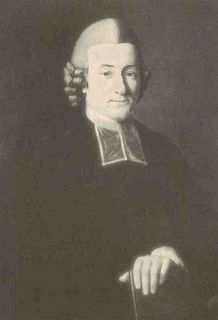History
The codex was given in 1661 by Parthenius, Patriarch of Constantinople, to Heneage Finch, Earl of Winchelesa, British Ambassador at the court of sultan. [3] It was known as Codex Bodleianus 5.
Sir Heneage Finch, 3rd Earl of Winchilsea (1628–1689) of Eastwell, Kent, was the 3rd Earl of Winchilsea.
It was added to the list of the New Testament manuscripts by Johann Jakob Wettstein. [4] [5] It was examined by Mill (as Bodleianus 7) and Griesbach. [2] According to Mill this codex is Stephen's ϛ'. [3]
Johann Jakob Wettstein was a Protestant Swiss theologian, best known as a New Testament critic.
John Mill was an English theologian.

Johann Jakob Griesbach, German biblical textual critic, was born at Butzbach, a small town in the state of Hesse-Darmstadt, where his father, Konrad Kaspar (1705–1777), was pastor. Griesbach's fame rests upon his work in New Testament criticism, in which he inaugurated a new epoch. His solution to the synoptic problem bears his name, but the Griesbach hypothesis has been modernly referred to as the Two-Gospel hypothesis.
The manuscript is sporadically cited in the critical editions of the Greek New Testament (UBS3). [6]
Currently the codex is located in the Bodleian Library (Auct. D. inf. 2.12) in Oxford. [1]

The Bodleian Library is the main research library of the University of Oxford, and is one of the oldest libraries in Europe. With over 12 million items, it is the second-largest library in Britain after the British Library. Under the Legal Deposit Libraries Act 2003 it is one of six legal deposit libraries for works published in the United Kingdom and under Irish Law it is entitled to request a copy of each book published in the Republic of Ireland. Known to Oxford scholars as "Bodley" or "the Bod", it operates principally as a reference library and, in general, documents may not be removed from the reading rooms.

Oxford is a university city in south central England and the county town of Oxfordshire. With a population of approximately 155,000, it is the 52nd largest city in the United Kingdom, with one of the fastest growing populations in the UK, and it remains the most ethnically diverse area in Oxfordshire county. The city is 51 miles (82 km) from London, 61 miles (98 km) from Bristol, 59 miles (95 km) from Southampton, 57 miles (92 km) from Birmingham and 24 miles (39 km) from Reading.
This page is based on this
Wikipedia article Text is available under the
CC BY-SA 4.0 license; additional terms may apply.
Images, videos and audio are available under their respective licenses.

Minuscule 17, ε 525 (Soden). It is a Greek-Latin minuscule manuscript of the New Testament, on 354 parchment leaves, dated palaeographically to the 15th century. It has some marginalia.
Minuscule 110, α 204 (Soden), is a Greek minuscule manuscript of the New Testament, on parchment leaves. Palaeographically it has been assigned to the 12th century. It has complex contents with full marginalia.
Lectionary 10, designated by siglum ℓ 10. It is a Greek manuscript of the New Testament, on vellum leaves. Palaeographically it has been assigned to the 13th-century. The manuscript is lacunose.
Lectionary 4, designated by siglum ℓ 4, is a Greek manuscript of the New Testament, on vellum leaves. Palaeographically it has been assigned to the 11th-century.
Lectionary 8, designated by sigla ℓ 8. It is a Greek manuscript of the New Testament, on vellum leaves. Palaeographically it has been assigned to the 14th-century.
Lectionary 9, designated by sigla ℓ 9. It is a Greek manuscript of the New Testament, on vellum leaves. Palaeographically it has been assigned to the 13th-century.
Lectionary 14 is designated by siglum ℓ 14. It is a Greek manuscript of the New Testament, on paper leaves. Palaeographically it has been assigned to the 16th century.
Lectionary 15, designated by siglum ℓ 15. It is a Greek manuscript of the New Testament, on vellum leaves. Palaeographically it has been assigned to the 13th-century.
Lectionary 16, designated by siglum ℓ 16. It is a Greek manuscript of the New Testament, on vellum leaves. Palaeographically it has been assigned to the 12th-century.
Lectionary 17, designated by siglum ℓ 17. It is a Greek manuscript of the New Testament, on vellum leaves. Palaeographically it has been assigned to the 9th-century.
Lectionary 18, designated by siglum ℓ 18. It is a Greek manuscript of the New Testament, on vellum leaves. Palaeographically it has been assigned to the 12th-century.
Lectionary 20, designated by siglum ℓ 20, is a Greek manuscript of the New Testament, on vellum leaves. It is dated by a colophon to the year 1047.
Lectionary 21, designated by siglum ℓ 21. It is a Greek manuscript of the New Testament, on vellum leaves. Palaeographically it has been assigned to the 14th-century.
Lectionary 22, designated by siglum ℓ 22. It is a Greek manuscript of the New Testament, on vellum leaves. Palaeographically it has been assigned to the 14th-century.
Lectionary 23, designated by siglum ℓ 23. It is a Greek manuscript of the New Testament, on vellum leaves. Palaeographically it has been assigned to the 11th-century.
Lectionary 24, designated by siglum ℓ 24. It is a Greek manuscript of the New Testament, on vellum leaves, known as Codex Radziwiłł. Palaeographically it has been assigned to the 10th-century.
Lectionary 26, designated by siglum ℓ 26. It is a Greek manuscript of the New Testament, on vellum leaves. Palaeographically it has been assigned to the 13th-century.
Lectionary 28, designated by siglum ℓ 28, is a Greek manuscript of the New Testament, on parchment leaves. Palaeographically it has been assigned to the 13th-century.
Lectionary 294 (Gregory-Aland), designated by siglum ℓ 294 is a Greek manuscript of the New Testament, on parchment. Palaeographically it has been assigned to the 9th or 10th century.
Lectionary 295 (Gregory-Aland), designated by siglum ℓ 295 is a Greek manuscript of the New Testament, on parchment. Palaeographically it has been assigned to the 9th or 10th century.






